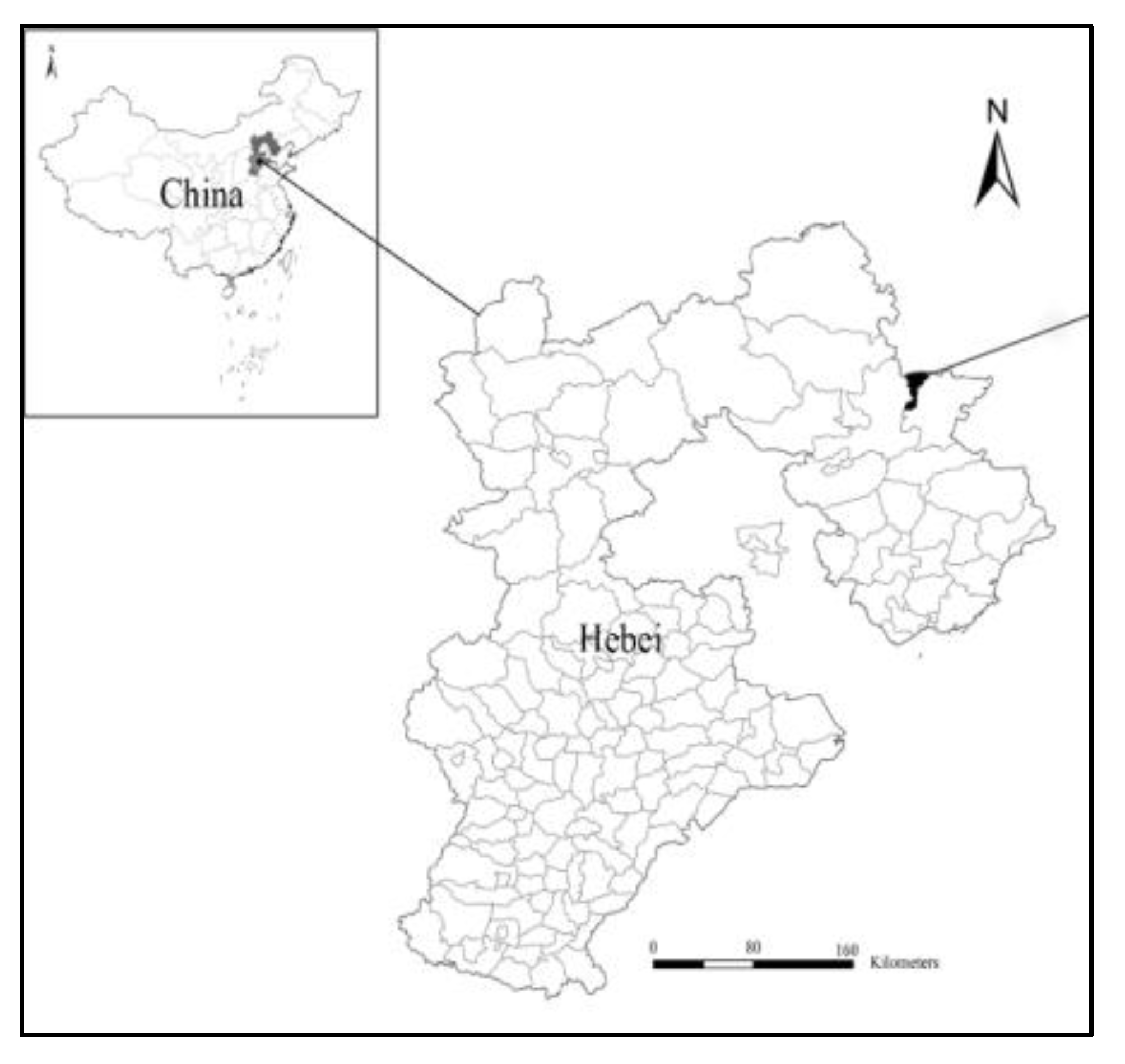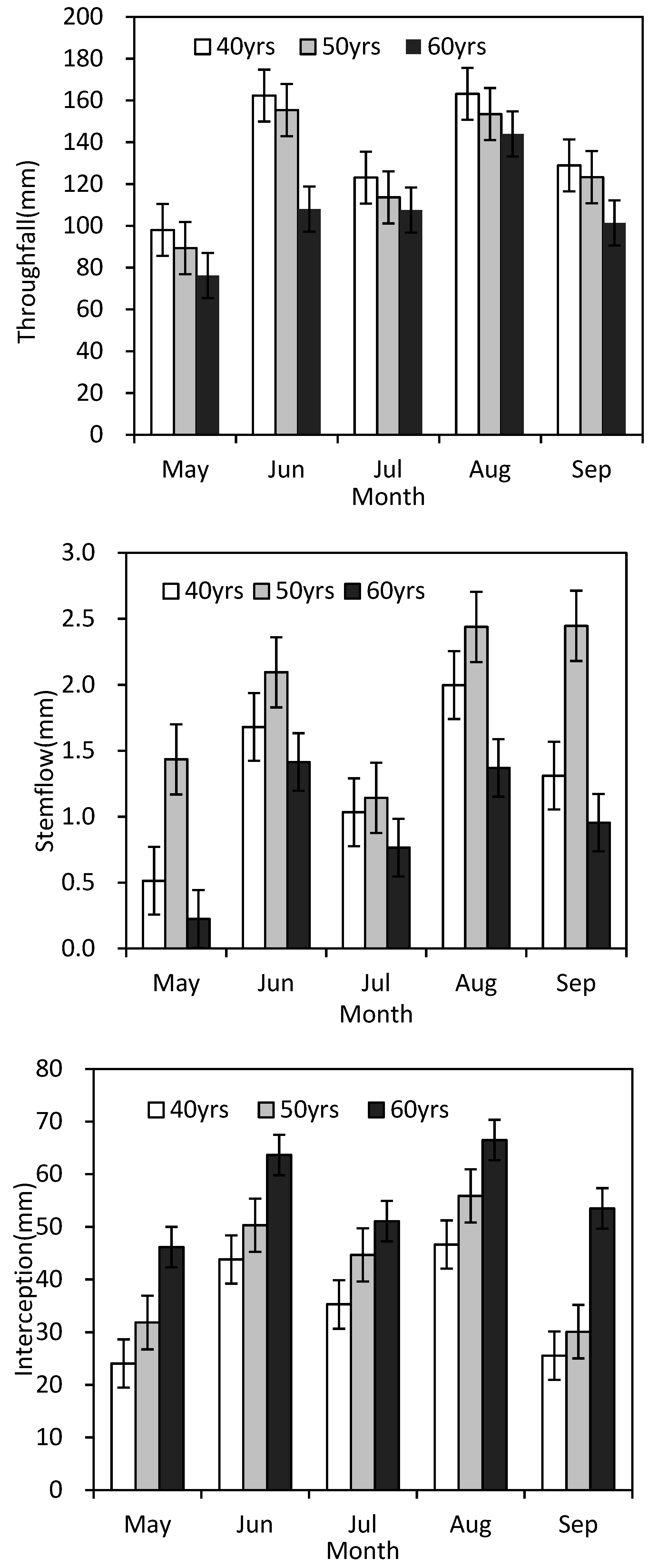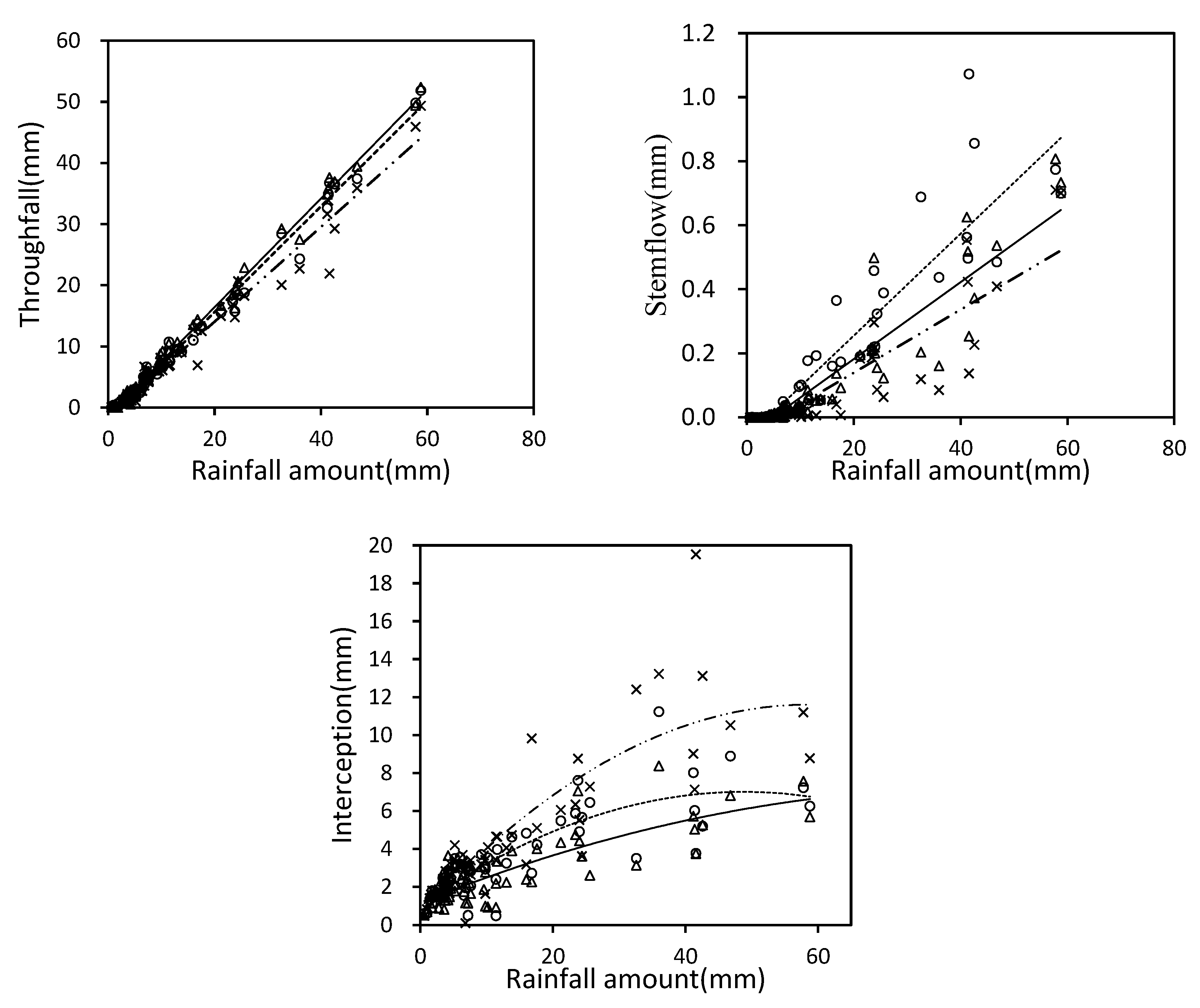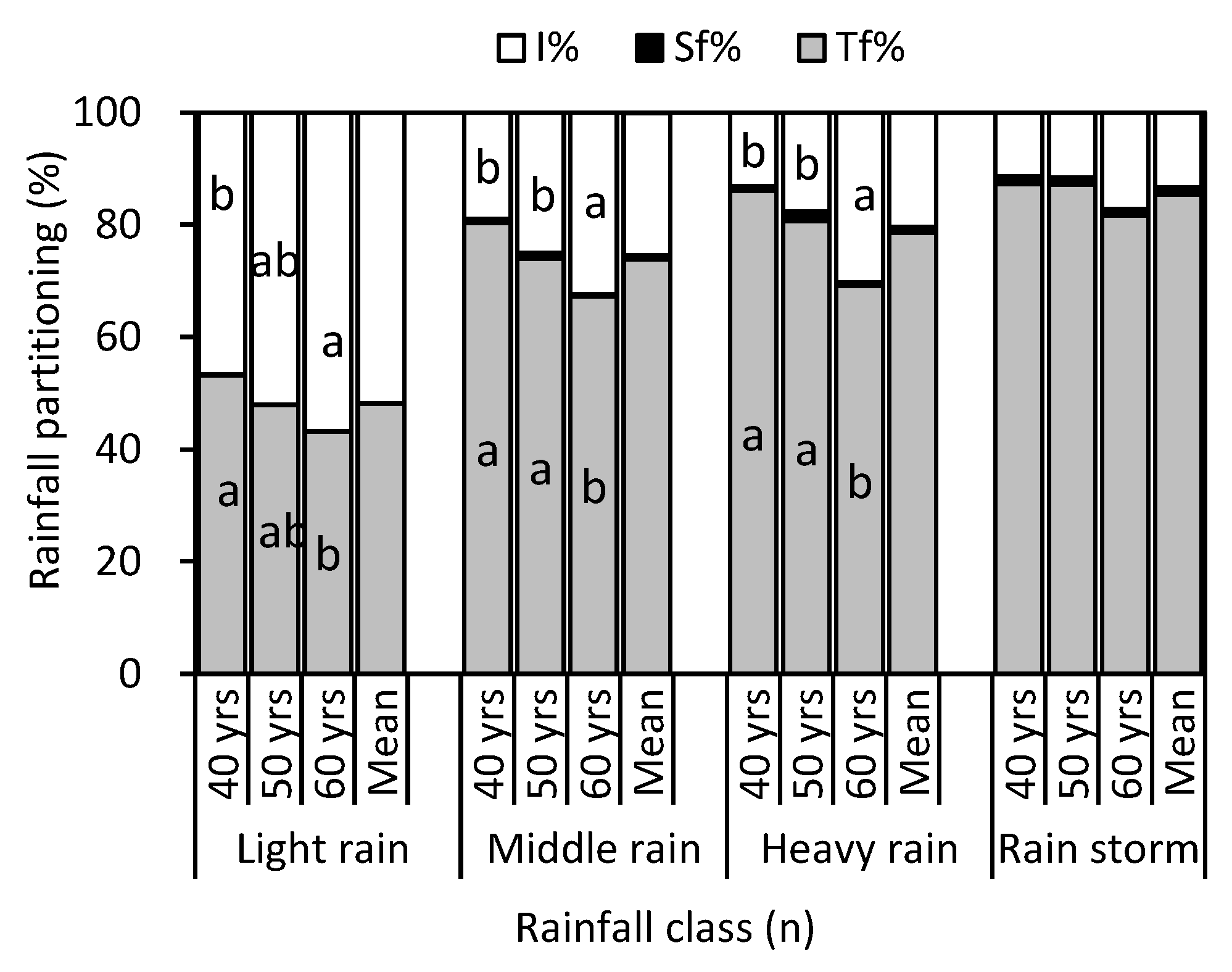Rainfall Partitioning in Chinese Pine (Pinus tabuliformis Carr.) Stands at Three Different Ages
Abstract
1. Introduction
2. Materials and Methods
2.1. Study Site
2.2. Collection of P, Tf, and Sf
2.3. Data Analysis
3. Results
3.1. Rainfall Pattern During the Study Period
3.2. Rainfall Partitioning Pattern Across Chinese Pine Stand Age
3.3. Dependence of Rainfall Partitioning on Rainfall Amount
3.4. Effect of Rainfall Intensity on Rainfall Partitioning
3.5. Effect of Canopy Features on Rainfall Partitioning
3.6. Comprehensive Analysis of Factors
4. Discussion
4.1. Age Dependence of Rainfall Partitioning
4.2. Effect of Rainfall Characteristic on Rainfall Partitioning
4.3. Forest Structure Dependence of Rainfall Partitioning
5. Conclusions
Author Contributions
Funding
Acknowledgments
Conflicts of Interest
References
- Brauman, K.A.; Freyberg, D.L.; Daily, G.C. Forest structure influences on rainfall partitioning and cloud interception: A comparison of native forest sites in Kona, Hawai’i. Agric. For. Meteorol. 2010, 150, 265–275. [Google Scholar] [CrossRef]
- Llorens, P.; Domingo, F. Rainfall partitioning by vegetation under Mediterranean conditions. A review of studies in Europe. J. Hydrol. 2007, 335, 37–54. [Google Scholar] [CrossRef]
- Ellison, D.; Futter, M.N.; Bishop, K. On the forest cover–water yield debate: From demand-to supply-side thinking. Glob. Chang. Biol. 2012, 18, 806–820. [Google Scholar] [CrossRef]
- Carlylemoses, D.E.; Gash, J.H.C. Rainfall Interception Loss by Forest Canopies. For. Hydrol. Biogeochem. 2011, 216, 407–423. [Google Scholar]
- Wang, D.; Wang, L. Canopy interception of apple orchards should not be ignored when assessing evapotranspiration partitioning on the loess plateau in China. Hydrol. Process. 2019, 33, 372–382. [Google Scholar] [CrossRef]
- Corti, G.; Agnelli, A.; Cocco, S.; Cardelli, V.; Masse, J.; Courchesne, F. Soil affects throughfall and stemflow under Turkey oak (Quercus cerris L.). Geoderma 2019, 333, 43–56. [Google Scholar] [CrossRef]
- Pryor, S.C.; Barthelmie, R.J. Liquid and chemical fluxes in precipitation, throughfall and stemflow: Observations from a deciduous forest and a red pine plantation in the midwestern USA. Water Air Soil Pollut. 2005, 163, 203–227. [Google Scholar] [CrossRef]
- Zou, C.B.; Caterina, G.L.; Will, R.E.; Stebler, E.; Turton, D. Canopy interception for a tallgrass prairie under juniper encroachment. PLoS ONE 2015, 10, e0141422. [Google Scholar] [CrossRef]
- Pérez-Suárez, M.; Arredondo-Moreno, J.T.; Huber-Sannwald, E.; Serna-Pérez, A. Forest structure, species traits and rain characteristics influences on horizontal and vertical rainfall partitioning in a semiarid pine-oak forest from central Mexico. Ecohydrology 2014, 7, 532–543. [Google Scholar] [CrossRef]
- Yang, X.G.; Chen, L.; Wang, L.; Wang, X.; Gu, J.L.; Qu, W.J.; Song, N.P. Dynamic rainfall-partitioning relationships among throughfall, stemflow, and interception loss by Caragana intermedia. J. Hydrol. 2019, 574, 980–989. [Google Scholar] [CrossRef]
- He, Z.B.; Yang, J.J.; Du, J.; Zhao, W.Z.; Liu, H.; Chang, X.X. Spatial variability of canopy interception in a spruce forest of the semiarid mountain regions of China. Agric. Meteorol. 2014, 188, 58–63. [Google Scholar] [CrossRef]
- Fathizadeh, O.; Attarod, P.; Keim, R.F.; Stein, A.; Amiri, G.Z.; Darvishsefat, A.A. Spatial heterogeneity and temporal stability of throughfall under individual Quercus brantii trees. Hydrol. Process. 2014, 28, 1124–1136. [Google Scholar] [CrossRef]
- Barbier, S.; Balandier, P.; Gosselin, F. Influence of several tree traits on rainfall partitioning in temperate and boreal forests: A review. Ann. For. Sci. 2009, 66, 602. [Google Scholar] [CrossRef]
- Sun, J.M.; Yu, X.X.; Wang, H.N.; Jia, G.D.; Zhao, Y.; Tu, Z.H.; Deng, W.P.; Jia, J.B.; Chen, J.G. Effects of forest structure on hydrological processes in China. J. Hydrol. 2018, 561, 187–199. [Google Scholar] [CrossRef]
- Holder, C.D. Rainfall interception and fog precipitation in a tropical montane cloud forest of Guatemala. For. Ecol. Manag. 2004, 190, 373–384. [Google Scholar] [CrossRef]
- Nytch, C.J.; Meléndez-Ackerman, E.J.; Pérez, M.E.; Ortiz-Zayas, J.R. Rainfall interception by six urban trees in San Juan, Puerto Rico. Urban Ecosyst. 2019, 22, 103–115. [Google Scholar] [CrossRef]
- Magliano, P.N.; Whitworth-Hulse, J.I.; Baldi, G. Interception, throughfall and stemflow partition in drylands: Global synthesis and meta-analysisa. J. Hydrol. 2019, 568, 638–645. [Google Scholar] [CrossRef]
- Aydm, M.; Sen, S.G.; Celik, S. Throughfall, stemflow, and interception characteristics of coniferous forest ecosystems in the western black sea region of turkey (daday example). Environ. Monit. Assess. 2018, 190, 316. [Google Scholar]
- Sheng, H.C.; Cai, T.J. Influence of Rainfall on Canopy Interception in Mixed Broad-Leaved—Korean Pine Forest in Xiaoxing’an Mountains, Northeastern China. Forests 2019, 10, 248. [Google Scholar] [CrossRef]
- Cuartas, L.A.; Tomasella, J.; Nobre, A.D.; Hodnett, M.G.; Waterloo, M.J.; Múnera, J.C. Interception water-partitioning dynamics for a pristine rainforest in Central Amazonia: Marked differences between normal and dry years. Agric. For. Meteorol. 2007, 145, 69–83. [Google Scholar] [CrossRef]
- Frasson, R.P.D.; Krajewski, M.W.F. Characterization of the drop-size distribution and velocity–diameter relation of the throughfall under the maize canopy. Agric. For. Meteorol. 2011, 151, 1244–1251. [Google Scholar] [CrossRef]
- Jeong, S.; Otsuki, K.; Farahnak, M. Stand structures and rainfall partitioning in dense unmanaged Japanese cypress plantations. J. Agric. Meteorol. 2019, 5, 92–102. [Google Scholar] [CrossRef]
- Del Campo, A.D.; González-Sanchis, M.; Lidón, A.; Ceacero, C.J.; García-Prats, A. Rainfall partitioning after thinning in two low-biomass semiarid forests: Impact of meteorological variables and forest structure on the effectiveness of water-oriented treatments. J. Hydrol. 2018, 565, 74–86. [Google Scholar] [CrossRef]
- Honda, E.A.; Mendonça, A.H.; Durigan, G. Factors affecting the stemflow of trees in the Brazilian Cerrado. Ecohydrology 2015, 8, 1351–1362. [Google Scholar] [CrossRef]
- Zhang, Y.F.; Wang, X.P.; Pan, Y.X.; Hu, R. Relative contribution of biotic and abiotic factors to stemflow production and funneling efficiency: A long-term field study on a xerophytic shrub species in Tengger Desert of northern China. Agric. For. Meteorol. 2020, 280, 107781. [Google Scholar] [CrossRef]
- Pypker, T.G.; Bond, B.J.; Link, T.E.; Marks, D.; Unsworth, M.H. The importance of canopy structure in controlling the interception loss of rainfall: Examples from a young and an old-growth Douglas-fir forest. Agric. Meteorol. 2005, 130, 113–129. [Google Scholar] [CrossRef]
- Brantley, S.T.; Miniat, C.F.; Bolstad, P.V. Rainfall partitioning varies across a forest age chronosequence in the southern appalachian mountains. Ecohydrology 2019, 12, e2081. [Google Scholar] [CrossRef]
- Calvo-Alvarado, J.C.; Jiménez-Rodríguez, C.D.; Calvo-Obando, A.J.; do Espírito-Santo, M.M.; Gonçalves-Silva, T. Interception of rainfall in successional tropical dry forests in Brazil and Costa Rica. Geosciences 2018, 8, 486. [Google Scholar] [CrossRef]
- Yan, W.; Deng, X.; Chen, X.; Tian, D.; Xiang, W.; Peng, Y. Long-term variations of rainfall interception in different growth stages of Chinese fir plantations. Hydrol. Sci. J. 2015, 60, 2178–2188. [Google Scholar] [CrossRef]
- Zhao, J.; Kang, F.; Wang, L.; Yu, X.; Zhao, W. Patterns of biomass and carbon distribution across a chronosequence of Chinese pine (Pinus tabulaeformis) forests. PLoS ONE 2014, 9, e94966. [Google Scholar] [CrossRef]
- Sadeghi, S.M.M.; Van Stan, J.T.; Pypker, T.G.; Friesen, J. Canopy hydrometeorological dynamics across a chronosequence of a globally invasive species, Ailanthus altissima (Mill., tree of heaven). Agric. For. Meteorol. 2017, 240, 10–17. [Google Scholar] [CrossRef]
- Sun, X.; Onda, Y.; Kato, H.; Gomi, T.; Liu, X. Estimation of throughfall with changing stand structures for Japanese cypress and cedar plantations. For. Ecol. Manag. 2017, 402, 145–156. [Google Scholar] [CrossRef]
- Carlyle-Moses, D.E.; Price, A.G. An evaluation of the Gash interception model in a northern hardwood stand. J. Hydrol. 1999, 214, 103–110. [Google Scholar] [CrossRef]
- Xiao, Y.; Chen, L.; Yu, X.; Yang, X.; Sun, Q. Influence on precipitation distribution of Pinus tabuleaefomis forest in Miyun Reservoir. J. Soil Water Conserv. 2007, 21, 154–157. [Google Scholar]
- Sharentu, Y.; Tian, Y.; Guo, L. Study on characteristics of distribution of rainfall in Pinus tabulaeformis plantation in Daqing-Mountains. J. Arid Land Resour. Environ. 2009, 23, 157–160. [Google Scholar]
- Liang, W. Simulation of Gash Model to Rainfall Interception of Pinus tabulaeformis. For. Syst. 2014, 23, 300–303. [Google Scholar] [CrossRef]
- Zhou, B.; Han, H.; Kang, F.; Cheng, X.; Song, Y.; Liu, K.; Li, Y. Characteristics of precipitation distribution in Pinus tabulaeformis plantations under different canopy coverage in Taiyue Mountain. Acta Ecol. Sin. 2013, 33, 1645–1653. [Google Scholar] [CrossRef]
- Ma, C.; Li, X.; Luo, Y.; Shao, M.; Jia, X. The modelling of rainfall interception in growing and dormant seasons for a pine plantation and a black locust plantation in semi-arid Northwest China. J. Hydrol. 2019, 577, 123849. [Google Scholar] [CrossRef]
- Kermavnar, J.; Vilhar, U. Canopy precipitation interception in urban forests in relation to stand structure. Urban Ecosyst. 2017, 20, 1373–1387. [Google Scholar] [CrossRef]
- Sadeghi, S.M.M.; Attarod, P.; Grant Pypker, T.; Dunkerley, D. Is canopy interception increased in semiarid tree plantations? Evidence from a field investigation in Tehran, Iran. Turk. J. Agric. For. 2014, 38, 792–806. [Google Scholar] [CrossRef]
- Zabret, K.; RakovecM, J.; Šraj, M. Influence of meteorological variables on rainfall partitioning for deciduous and coniferous tree species in urban area. J. Hydrol. 2018, 558, 29–41. [Google Scholar] [CrossRef]
- Jiang, H.; Zhao, Y.; Xin, X.; Ma, W.; Li, X.; Sun, C.; Guo, X. Precipitation Distribution Laws of Different Forest Stand in Daxing’anling. J. Soil Water Conser. 2008, 22, 197–201. [Google Scholar]
- Saito, T.; Matsuda, H.; Komatsu, M.; Xiang, Y.; Takahashi, A.; ShinoharaK, Y.; Otsuki, K. Forest canopy interception loss exceeds wet canopy evaporation in Japanese cypress (Hinoki) and Japanese cedar (Sugi) plantations. J. Hydrol. 2013, 507, 287–299. [Google Scholar] [CrossRef]
- Iida, S.i.; Levia, D.F.; Shimizu, A.; Shimizu, T.; Tamai, K.; Nobuhiro, T.; Kabeya, N.; Noguchi, S.; Sawano, S.; Araki, M. Intrastorm scale rainfall interception dynamics in a mature coniferous forest stand. J. Hydrol. 2017, 548, 770–783. [Google Scholar] [CrossRef]
- Zhang, Y.F.; Wang, X.P.; Hu, R.; Pan, Y.X.; Zhang, H. Stemflow in two xerophytic shrubs and its significance to soil water and nutrient enrichment. Ecol. Res. 2013, 28, 567–579. [Google Scholar] [CrossRef]
- Li, X.Y.; Liu, L.Y.; Gao, S.Y.; Ma, Y.J.; Yang, Z.P. Stemflow in three shrubs and its effect on soil water enhancement in semiarid loess region of China. Agric. For. Meteorol. 2008, 148, 1501–1507. [Google Scholar] [CrossRef]
- Rahmani, R.; Sadoddin, A.; Ghorbani, S. Measuring and modelling precipitation components in an Oriental beech stand of the Hyrcanian region, Iran. J. Hydrol. 2011, 404, 294–303. [Google Scholar] [CrossRef]
- Zimmerman, A.; Zimmermann, B.; Elsenbeer, H. Rainfall redistribution in a tropical forest: Spatial and temporal patterns. Water Resour. Res. 2009, 45, W11413. [Google Scholar] [CrossRef]
- Gardon, F.R.; Toledo, R.M.D.; Brentan, B.M.; Santos, R.F.D. Rainfall interception and plant community in young forest restorations. Ecol. Indic. 2020, 109, 105779. [Google Scholar] [CrossRef]
- Li, X.; Xiao, Q.; Niu, J.; Dymond, S.; van Doorn, N.S.; Yu, X.; Xie, B.; Lv, X.; Zhang, K.; Li, J. Process-based rainfall interception by small trees in Northern China: The effect of rainfall traits and crown structure characteristics. Agric. For. Meteorol. 2016, 218, 65–73. [Google Scholar] [CrossRef]
- Liang, W.; Kosugi, K.; Takahisa, M. Characteristics of stemflow for tall stewartia (Stewartia monadelpha) growing on a hillslope. J. Hydrol. 2009, 378, 168–178. [Google Scholar] [CrossRef][Green Version]
- Sadeghi, S.M.M.; Stan, J.T.V.; Pypker, T.G.; Tamjidi, J.; Farahnaklangroudi, M. Importance of transitional leaf states in canopy rainfall partitioning dynamics. Eur. J. For. Res. 2018, 1, 1–10. [Google Scholar] [CrossRef]
- César Cisneros Vaca, C.; van der Tol, C.; Ghimire, C.P. The influence of long-term changes in canopy structure on rainfall interception loss: A case study in speulderbos, the netherlands. Hydrol. Earth Syst. Sci. 2018, 22, 1–42. [Google Scholar] [CrossRef]
- Liu, C.; Wang, Y.; Ma, C.; Wang, Y.; Zhang, H.; Hui, B. Quantifying the effect of non-spatial and spatial forest stand structure on rainfall partitioning in mountain forests, southern China. For. Chron. 2018, 94, 162–172. [Google Scholar] [CrossRef]
- Fang, S.; Zhao, C.; Jian, S. Spatial variability of throughfall in a Pinus tabulaeformis plantation forest in Loess Plateau, China. Scand. J. Forest Res. 2016, 31, 467–476. [Google Scholar] [CrossRef]
- Muzylo, A.; Llorens, P.; Valente, F.; Keizer, J.J.; Domingo, F.; Gash, J.H.C. A review of rainfall interception modelling. J. Hydrol. 2009, 370, 191–206. [Google Scholar] [CrossRef]





| Age (Years) | Slope (°) | Density (Trees hm−2) | Mean DBH (cm) | Mean Height (m) | LAI (m2/m2) | GapFraction (%) | Openness (%) | Mean Leaf Angle (Degree) |
|---|---|---|---|---|---|---|---|---|
| 40 | 27 | 1017 | 16.1 | 11.3 | 2.5 | 14.1 | 15.1 | 30.6 |
| 50 | 17 | 634 | 20.6 | 15.6 | 2.6 | 13.3 | 14.2 | 27.2 |
| 60 | 18 | 434 | 30.4 | 20.7 | 2.8 | 11.0 | 11.6 | 24.1 |
| Stand Age (Years) | Stemflow Tree Number (n) | DBH (cm) | Crown (m × m) |
|---|---|---|---|
| 40 | 1 | 13.8 | 3.5 ×3.9 |
| 2 | 17.8 | 4.5 × 4.8 | |
| 3 | 20.6 | 4.8 × 5.6 | |
| 4 | 24.6 | 4.9 × 5.5 | |
| 5 | 29.8 | 4.9 × 6.0 | |
| 50 | 1 | 7.5 | 2.0 × 1.5 |
| 2 | 14.2 | 3.4 × 2.8 | |
| 3 | 20.1 | 5.1 × 5.8 | |
| 4 | 26.2 | 5.6 × 9.2 | |
| 5 | 32.4 | 7.5 × 8.9 | |
| 60 | 1 | 24.8 | 5.8 × 5.4 |
| 2 | 27.7 | 4.8 × 6.3 | |
| 3 | 33.5 | 6.3 × 6.8 | |
| 4 | 36.2 | 7.9 × 7.2 | |
| 5 | 40.8 | 10.3 × 5.8 |
| Rainfall Intensity Class (mm d−1) | 2013 | 2014 | 2013–2014 | |||
|---|---|---|---|---|---|---|
| Amount (mm) | Frequency (N) | Amount (mm) | Frequency (N) | Amount (mm) | Frequency (N) | |
| 0.2 ≤ P < 10 | 113.4 | 23 | 81 | 17 | 194.4 | 40 |
| 10 ≤ P < 25 | 117.8 | 6 | 120.8 | 8 | 238.6 | 14 |
| 25 ≤ P < 50 | 129.4 | 3 | 178.4 | 5 | 307.8 | 8 |
| 50 ≤ P < 100 | 116.6 | 2 | 0 | 0 | 116.6 | 2 |
| Total rainfall | 477.2 | 34 | 380.2 | 30 | 857.4 | 64 |
| Stand Age (Years) | Tf (mm) | Tf% | Sf (mm) | Sf% | I (mm) | I% |
|---|---|---|---|---|---|---|
| 40 | 675.6 | 78.8 | 6.5 | 0.8 | 175.3 | 20.4 |
| 50 | 635.1 | 74.1 | 9.6 | 1.1 | 212.7 | 24.8 |
| 60 | 571.8 | 66.7 | 4.7 | 0.6 | 280.8 | 32.8 |
| Item | Model | Regression Parameters | |||
|---|---|---|---|---|---|
| F | P | SE | R² | ||
| Tf | y40 = 0.8880x − 1.3413 | 9778.122 | 0.000 | 1.027 | 0.997 |
| y50 = 0.8639x − 1.6400 | 6188.525 | 0.000 | 1.256 | 0.995 | |
| y60 = 0.7744x − 1.4400 | 2168.431 | 0.000 | 1.903 | 0.972 | |
| Sf | y40= 0.0120x − 0.0589 | 360.983 | 0.000 | 0.072 | 0.851 |
| y50 = 0.0159x − 0.0642 | 361.028 | 0.000 | 0.096 | 0.851 | |
| y60 = 0.0099x − 0.0582 | 232.573 | 0.000 | 0.074 | 0.786 | |
| I | y40 = −0.0008x2 + 0.1406x + 1.1676 | 65.793 | 0.000 | 1.004 | 0.673 |
| y50 = −0.0025x2 + 0.2468x + 0.9891 | 75.555 | 0.000 | 1.174 | 0.703 | |
| y60 = −0.0032x2 + 0.3765x + 0.5784 | 95.650 | 0.000 | 1.830 | 0.750 | |
| Item | Influencing Factor | Model | N |
|---|---|---|---|
| Tf | Rainfall amount(x1), LAI(x2) | y = 12.574 + 0.842x1 − 5.335x2 | 192 |
| Sf | Rainfall amount(x1), density(x2), mean leaf angle(x3) | y = 0.013x1 − 0.001x2 + 0.075x3 − 1.567 | 192 |
| I | Rainfall amount(x1), LAI(x2) | y = 0.145x1 + 5.472x2 − 12.871 | 192 |
| Location | Forest Type | Age (Years) | Study Period | Tf% | Sf% | I% | Literature |
|---|---|---|---|---|---|---|---|
| Boreal and temperate biogeographical zones | conifers | - | - | 64.5 0 | 4.10 | 28.7 0 | Barbier et al. 2009 |
| Taiyue Mountain, China | Pinus tabulaeformis | 20 | May to September 2011 | 77.89 | 2.30 | 19.92 | Zhou et al. 2013 |
| Miyun Reservoir, China | Pinus tabulaeformis | 33 | 2004–2006 | 67.65 | 0.68 | 31.67 | Xiao et al. 2007 |
| Yeheshan watershed, China | Pinus tabulaeformis | 17 | January–December 2016 | 75.40 | 0.70 | 23.90 | Ma et al. 2019 |
| Chitgar Forest Park, Iran | Pinus eldarica | 42 | 30 January 2011 to 30 January 2012 | 44.20 | Sadeghi et al. 2014 | ||
| urban area of Ljubljana, Slovenia | Pinus nigra | - | January 2014 to June 2017 | 28.00 | 0.02 | 72.00 | Zabret, Rakovec and Šraj 2018 |
| Bezirgan Basin, Turkey | Pinus nigra | - | 2012–2014 | 69.80 | 2.60 | 27.70 | Aydm, Şen and Celik 2018 |
| Bezirgan Basin, Turkey | Pinus sylvestris | - | 2012–2014 | 73.9 | 5.90 | 20.20 | Aydm, Şen and Celik 2018 |
| Bezirgan Basin, Turkey | mixed Pinus nigra–Pinus sylvestris | - | 2012–2014 | 77.70 | 3.10 | 19.20 | Aydm, Şen and Celik 2018 |
| Daxing’anling, China | Pinus sylvestris var. mongolica | 32 | 18 May–September 11 2007 | 68.51 | 0.54 | 31.00 | Jiang et al.2008 |
| Sierra San Miguelito, Mexico | Pinus cembroides | 81 | June 2006 to July 2009 | 92.23 | 3.76 | 18.95 | Pérez-Suárez et al.2014 |
| Daxing’anling, China | Picea koraiensis | 20 | 18 May–11 September 2007 | 66.00 | 1.04 | 33.50 | Jiang et al. 2008 |
| Daxing’anling, China | Larix gmelinii | 32 | May 18–September 11 2007 | 59.76 | 0.35 | 40.20 | Jiang et al. 2008 |
| Fukuoka, Japan | Chamaecyparis obtusa | 33 | April to October 2017 | 49.40 | 22.60 | 28.00 | Jeong, Kyoichi and Farahnak, 2019 |
| Fukuoka, Japan | Chamaecyparis obtusa | 41 | 5 June 2010 to 31 December 2011 | 65.30 | 9.10 | 25.50 | Saito et al. 2013 |
| Fukuoka, Japan | Cryptomeria japonica | 41 | 5 June 2010 to 31 December 2011 | 67.90 | 6.60 | 25.50 | Saito et al. 2013 |
| Tsukuba Experimental Watershed, Japan | Cryptomeria japonica | 50 | 2008 and 2010 | 76.90 | 3.20 | 19.90 | Iida et al. 2017 |
| Changbai Mountains, China | mixed forest of broad-leaved and Pinus koaiensis | - | growing seasons in 2010 and 2011 | 21.95 | Sheng and Cai 2019 | ||
| Ljubljana, Slovenia | mixed (upland) forest including Picea abies | - | 1 January 2008 to 31 December 2013 | 94.1 | 2.00 | 3.90 | Kermavnar et al. 2017 |
| Chitgar Forest Park, Iran | Cupressus arizonica | 42 | 30 January 2011 to 30 January 2012 | 34.40 | Sadeghi et al. 2014 |
© 2020 by the authors. Licensee MDPI, Basel, Switzerland. This article is an open access article distributed under the terms and conditions of the Creative Commons Attribution (CC BY) license (http://creativecommons.org/licenses/by/4.0/).
Share and Cite
Dong, L.; Han, H.; Kang, F.; Cheng, X.; Zhao, J.; Song, X. Rainfall Partitioning in Chinese Pine (Pinus tabuliformis Carr.) Stands at Three Different Ages. Forests 2020, 11, 243. https://doi.org/10.3390/f11020243
Dong L, Han H, Kang F, Cheng X, Zhao J, Song X. Rainfall Partitioning in Chinese Pine (Pinus tabuliformis Carr.) Stands at Three Different Ages. Forests. 2020; 11(2):243. https://doi.org/10.3390/f11020243
Chicago/Turabian StyleDong, Lingling, Hairong Han, Fengfeng Kang, Xiaoqin Cheng, Jinlong Zhao, and Xiaoshuai Song. 2020. "Rainfall Partitioning in Chinese Pine (Pinus tabuliformis Carr.) Stands at Three Different Ages" Forests 11, no. 2: 243. https://doi.org/10.3390/f11020243
APA StyleDong, L., Han, H., Kang, F., Cheng, X., Zhao, J., & Song, X. (2020). Rainfall Partitioning in Chinese Pine (Pinus tabuliformis Carr.) Stands at Three Different Ages. Forests, 11(2), 243. https://doi.org/10.3390/f11020243





